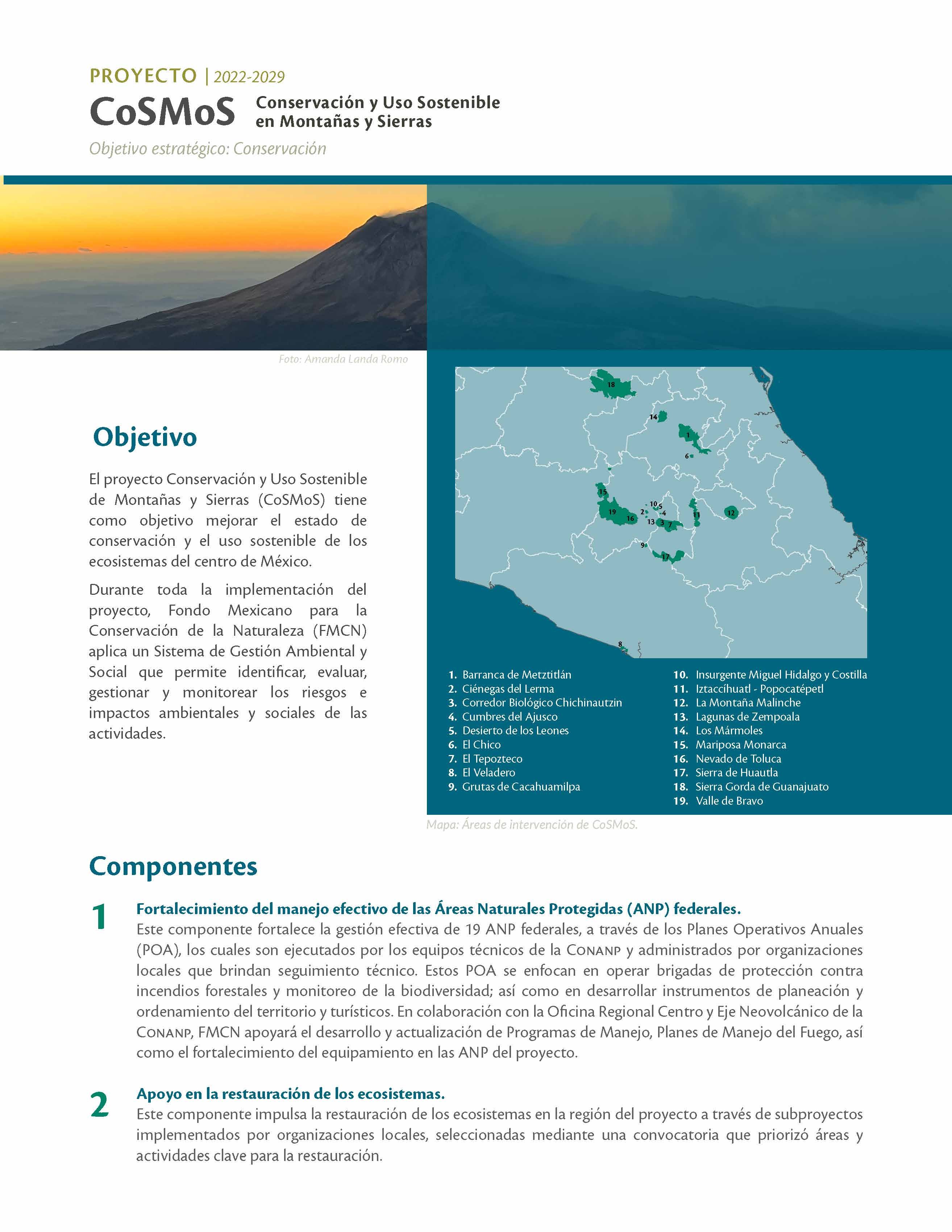CoSMoS
Conservation and Sustainable Use of Mountains and Mountain Ranges (CoSMoS, acronym in Spanish) aims to improve the conservation status and sustainable use of ecosystems in central Mexico.
The Project
The objective of the Conservation and Sustainable Use of Mountains and Mountain Ranges (CoSMoS, Spanish acronym) project is to improve the state of conservation and sustainable use of the ecosystems of central Mexico.
Context
Within the framework of Mexico-Germany cooperation, both countries agreed to the joint development of CoSMoS. The project was born with the idea of carrying out conservation, restoration, and sustainable use actions on the route that Alexander von Humboldt, the German scientist, followed on his five-year trip through Latin America. In 1803, Humboldt arrived in Mexico, disembarking in the port of Acapulco to settle in Mexico City, from where he left for different destinations in the mountains of the Neovolcanic Axis and the Altiplano, setting sail from the port of Veracruz.
CoSMoS embodies the current vision of the Government of Mexico to strengthen the sustainable management of the territory, improve the effective management of its protected areas (PAs) and areas of influence, and strengthen the communities that inhabit them, facing new global challenges, such as the recent COVID-19 pandemic and the effects of climate change.
The lines of work that guide CoSMoS’ actions are:
- Strengthen the effective management of federal PAs.
- Support the restoration of ecosystems.
- Promote the sustainable use and exploitation of ecosystem goods and services provided by federal PAs (strengthen the local economy).
- Contribute to developing digital infrastructure and applied technology to improve decision-making, effective communication, and environmental education regarding biodiversity conservation.
CoSMoS will promote the conservation and sustainable use of the mountain ecosystems of central Mexico.
Achievements
In 2023, Mexican Fund for the Conservation of Nature (FMCN) established the project coordination unit and developed the plan that will guide all CoSMoS actions over five years. As part of this phase, a social and environmental assessment was conducted to identify potential risks associated with the proposed activities and to establish effective mitigation measures.
In parallel, FMCN and the National Commission of Natural Protected Areas (Conanp, acronym in Spanish) collaborated on five-year strategic planning for the 19 Protected Areas (PAs) supported by CoSMoS. This included the development of Annual Operational Plans (POAs, acronym in Spanish) and the identification of environmental and social safeguards.
An alliance was also established with the National Commission for the Knowledge and Use of Biodiversity (Conabio, acronym in Spanish), which will design and implement a monitoring system to assess the conservation status and threats to ecosystems within the CoSMoS project area.
FMCN allocated resources to implement POAs in 19 PAs, led by Conanp’s technical teams and supported by local organizations providing technical and administrative assistance. A call for proposals was launched to finance ecosystem restoration projects, with selected proposals set to begin implementation in the first quarter of 2025.
Additionally, through calls and both in-person and virtual participatory workshops, FMCN and Conanp identified more than 100 community enterprises that will receive support from Local Technical Assistance Providers (PLATs, acronym in Spanish). These PLATs will carry out assessments and develop tailored improvement plans in the first half of 2025, with implementation scheduled for the second half of the year. The objective is to improve operations, increase profitability, and promote the sustainable use of natural resources offered by the PAs.
Through the operation of the 19 POAs, PAs have acquired office equipment, personal protective gear for fire brigades, digital radios, tools for wildfire management, portable weather stations, binoculars, field guides, and camera traps. Investments have also been made in key infrastructure rehabilitation, including a new fire watchtower in Los Mármoles National Park, a new guard station in El Veladero National Park, the rehabilitation of a community forest nursery in the Monarch Butterfly Biosphere Reserve, the renewal of the Zempoala Conservation Culture Center, and the renovation of the Tourist Information Center at the Cacahuamilpa Caves.
Furthermore, workshops and consulting sessions were held to update management programs and develop strategies for pest and forest disease prevention in sites such as San Cayetano, Los Mármoles National Park, and El Chico National Park. A major milestone was the completion of the management program for El Veladero National Park, which is currently under review and expected to be published in the first half of 2025.

Allies
Donor: KfW Development Bank
Partners:
- National Commission of Natural Protected Areas (Conanp, acronym in Spanish)
- National Commission for the Use and Knowledge of Biodiversity (Conabio, acronym in Spanish)
Contact
To address any questions, clarifications, suggestions, complaints, or comments related to CoSMoS, we provide you with the following means of contact corresponding to the project's Complaints and Inquiries Mechanism. Your request will be treated with confidentiality, responsibility, and interest by the representatives of the project.
E-mail: denuncia@fmcn.org
Postal address: Francisco Sosa 102. Santa Catarina. Delegación Coyoacan. CDMX. C.P. 04010.
Telephone: 55 5611 9779